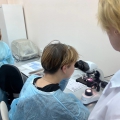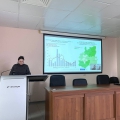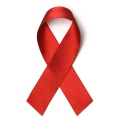May 18 - World AIDS Remembrance Day
Print version|
18 05.2025
Every year on the third Sunday of May, in accordance with the decision of the WHO, World AIDS Remembrance Day is celebrated.
|
The first World AIDS Remembrance Day was celebrated in 1983 in San Francisco to draw the world's attention to the problems of AIDS patients and the spread of the disease in the world. In 1985, the idea of creating a multi-colored canvas - a quilt sewn from scraps of fabric in memory of the many people who died of AIDS - was invented by San Francisco activist Clive Jones. A few years later, a symbol of the movement against this disease appeared - a red ribbon pinned to clothing. This emblem was created in 1991 by American artist Frank Moore, who died of AIDS in 2002 at the age of 48. Currently, World AIDS Remembrance Day is known as AIDS Remembrance Day. The Volga District Center for AIDS Prevention and Control of the Federal Budgetary Scientific Institution NNIIEM named after I.N. Blokhina of Rospotrebnadzor monitors and analyzes the epidemiological situation of HIV infection in the subjects of the district. By the beginning of 2025, 214,124 HIV-infected people were subject to dispensary observation in the Volga Federal District. The epidemic process of HIV infection in the Volga Federal District in 2024 was characterized by a persistently high level of infection of the population (750.20 / 0000) with an excess of the average district level in four regions of the district: Perm Krai (1416.70 / 0000), Samara (1325.00 / 0000), Orenburg (1163.10 / 0000) and Ulyanovsk (1082.50 / 0000) regions. In 2024, according to data from territorial centers for the prevention and control of AIDS and infectious diseases, 12,146 new cases of HIV infection were identified in the district, which is the lowest number in the past three years. The growth rate of new registered cases of HIV infection in the district was negative (-7.7%).
The total number of HIV-infected people who died from all causes in 2024 was 9,056 people (in 2023 - 9,983 people), of which 3,051 people died due to HIV infection (in 2023 - 3,598 people). The growth rate of the number of HIV-infected people who died from all causes was negative -9.3%, as in the cohort of deaths due to HIV infection -15.2%. The average district mortality rate in the district in the reporting year decreased (by 8.9%) compared to 2023 (31.70/0000 versus 34.80/0000). In 2024, the mortality rate was higher than the district average in five regions of the district: Samara Region (70.00/0000), Perm Region (56.60/0000), Ulyanovsk Region (45.50/0000), Udmurt Republic (39.50/0000), Orenburg Region (36.30/0000). The minimum values were recorded in Kirov Region (6.80/0000) and the Republic of Mordovia (7.60/0000). The share of deaths due to HIV infection among deaths of HIV-positive people from all causes in the district in 2024 was 33.7% (versus 36.0% in 2023).
There is currently no cure for the disease caused by the human immunodeficiency virus. However, the availability of modern preventive and diagnostic tools, as well as drugs for the treatment of HIV infection and opportunistic diseases, and the wide access of people living with HIV (PLHIV) to the system of dispensary observation and care have made it possible to transfer HIV infection to the category of chronic diseases with a controlled course.
One of the priority tasks of the state strategy to counter the spread of HIV infection in the Russian Federation for the period up to 2030 is to increase the coverage of antiretroviral therapy (ART) for people infected with HIV.
In the Volga Federal District, a positive growth rate in the number of people living with HIV receiving therapy was revealed in the period from 2016 to 2024. Their number in 2024 amounted to 184,158 people, which is 2.3% more than in 2023, 16,398 HIV-infected people were taken for treatment for the first time.
The coverage of patients under observation with therapy in 2024 amounted to 90.6% on average in the Volga Federal District, an increase in the coverage of patients with ART compared to 2023 was noted in nine of the 14 subjects of the district. The coverage of HIV-infected children with therapy was significantly higher than in the general patient population, amounting to 99.6%. At the same time, of the total number of HIV-infected individuals subject to observation, ART coverage was 86.0%, which is below the target indicator defined by the Strategy for 2024 (at least 87%). Thus, the HIV epidemic continues to develop. Improving the effectiveness of the response to the epidemic requires more active implementation of systemic measures, including both the prevention of new cases of HIV infection and an increase in treatment coverage for people living with HIV, including monitoring the implementation of chemoprophylaxis of perinatal transmission of the virus.
Specialists of the Volga District Center for the Prevention and Control of AIDS carry out work on genotyping the human immunodeficiency virus. The results obtained allow doctors to choose alternative drugs for prescribing effective treatment regimens, which will help maintain the health, performance and quality of life of an HIV-positive person and slow down the spread of infection. The Center's specialists also conduct preventive measures on HIV infection with teachers of educational institutions and young people. Increasing public awareness of the problem of HIV infection, the use of preventive measures together with early diagnosis and timely initiation of treatment of infected individuals is one of the most important factors in countering the epidemic. A healthy lifestyle and responsible behavior are the basis for preventing HIV infection.







